The Role of Drying Speed in Solvent Ink Performance and Print Efficiency
How drying speed impacts print quality, adhesion, and production throughput
The drying speed of solvent ink plays a big role when trying to get good print quality, proper adhesion, and keep production running smoothly. When ink dries too fast, say under 15 seconds, it often doesn't stick well enough to those polyethylene films we work with, which means there's a real chance of ink rubbing off when people handle the printed materials. Things get just as problematic if the ink takes longer than 30 seconds to dry. This happens quite a bit actually in our high speed flexo printing setups where we see smudges forming all over the place. The slowdown from these issues can cut down our output by around 40 percent when we have multiple passes going through the press at once.
Differences in drying behavior between standard and eco-solvent inks on polyethylene
Standard solvent inks, typically based on toluene or xylene, dry 20–25% faster than eco-solvent alternatives on untreated LDPE. However, eco-solvent inks perform better on corona-treated films despite their higher boiling points (130–160°C vs. 90–120°C), offering a practical compromise between lower VOC emissions and reliable drying performance.
Balancing fast drying with risk of defects: skinning, clogging, and misting
When drying gets pushed too hard, three big problems tend to pop up. First off, skinning happens when a thin layer forms on top of the ink surface (about half to two micrometers thick). This creates a barrier that traps solvents underneath, which then causes bubbles to form. Another common issue is nozzle clogs. Studies show these account for nearly four out of five printhead failures in systems where drying happens quickly because resins start to harden inside the nozzles. And there's also the problem with air flow. If the speed goes over 3.2 meters per second in those drying tunnels, it creates mist. Tiny ink particles get into the air (less than ten micrometers), and they end up contaminating both the materials being printed on and the machines themselves.
Typical optimal drying window: 15–30 seconds at 60–80°C for flexo and rotogravure
Studies have found that around 22 to 28 seconds at about 70 plus or minus 5 degrees Celsius works best for drying solvent ink on polyethylene films that are between 40 and 60 micrometers thick. When dried within this window, most of the solvent evaporates away completely, leaving behind only trace amounts of moisture under 0.3 percent. The surface finish stays pretty consistent too, with variations in gloss typically staying under 5 percent from one batch to another. For rotogravure printing operations, things happen a bit quicker since they work with much thinner ink layers measuring around 8 to 12 micrometers. These setups usually need just 15 to 20 seconds. Flexographic printing takes longer though because the ink deposits are thicker, generally needing 25 to 30 seconds for proper drying when dealing with films about 15 to 20 micrometers thick. Industry professionals who implement infrared monitoring during production report seeing significant improvements. They find their rework rates drop by approximately two thirds compared to what happens when drying parameters aren't properly optimized.
Substrate Characteristics and Their Influence on Solvent Ink Drying
Surface Energy Challenges with LDPE and HDPE Films
LDPE and HDPE films present adhesion challenges due to low surface energy (30–34 dyne/cm), resulting in poor wetting and issues like pinholes and reduced color density. To overcome this, solvent inks must have surface tension ≥30 mN/m. Even then, long-term durability under mechanical stress remains limited without surface treatment.
Primed vs. Unprimed Surfaces: Effects on Ink Absorption and Drying Uniformity
Primed films improve drying consistency by 40–60% over unprimed ones, thanks to microporous layers that regulate solvent absorption. On unprimed surfaces, 70% of solvent evaporates vertically through the ink layer, increasing bubble formation risks. In contrast, primed substrates facilitate lateral diffusion, enabling more uniform drying and stronger film integrity.
Enhancing Drying Efficiency Through Corona Treatment and Surface Modification
When we apply corona treatment to LDPE or HDPE materials, it raises their surface energy levels between 38 and 42 dynes per centimeter through oxidation processes. This makes those surfaces bond much better with solvent-based inks at a molecular level. Our flexographic printing tests revealed some pretty impressive results when applying corona treatment at around 50 watts per square meter. Drying times dropped by nearly a quarter, adhesion improved almost a third, and defects got cut down by close to 30%. Flame treatment works too but doesn't deliver quite the same boost in performance metrics. For high speed bag printing operations, combining plasma pretreatment techniques with specially formulated high polarity solvents can actually shave anywhere from 30 to 45 precious seconds off drying cycles without compromising optical quality standards (less than 2% haze remains acceptable).
Environmental and Process Conditions Affecting Solvent Ink Drying
Controlling Ambient Temperature and Humidity in High-Speed Printing Environments
Maintaining ambient conditions at 22–24°C and 45–55% RH ensures consistent drying performance. High humidity slows evaporation, causing ink pooling on polyethylene, while low humidity accelerates drying and raises clogging risks. Climate-controlled environments reduce print defects by 18–22% compared to unregulated spaces. Real-time sensors allow dynamic adjustments for seasonal changes, minimizing downtime.
Optimizing Airflow in Drying Tunnels to Prevent Blocking and Ink Misting
Good control over airflow cuts down on ink misting problems that can actually cause between 12 and 15 percent material loss during gravure printing operations. When nozzles are positioned correctly, they help spread air evenly across the surface, so drying times stay pretty consistent within about two seconds either way. The crossflow system approach manages to get rid of solvents approximately thirty percent quicker compared to traditional vertical airflow setups, all without messing up the adhesion properties. And for those working with low energy LDPE materials, it's really important to keep turbulence levels beneath five percent because otherwise the ink film tends to distort quite badly.
Infrared vs. Hot Air Drying: Energy Efficiency and Drying Consistency Trade-Offs
Infrared drying actually uses around 30 to 40 percent less energy compared to traditional hot air systems because it heats the ink layer directly rather than warming up the entire environment. But there's a catch when dealing with uneven surfaces. These can lead to spots getting way too hot, sometimes hitting temperatures over 90 degrees Celsius, which might damage the resin in the process. Many operations now use hybrid approaches where infrared handles the initial drying phase and then switches to hot air for the final touches. This combination typically keeps moisture levels within about 5% difference across the product and saves roughly a quarter of what would otherwise be spent on energy costs. Worth noting that infrared works particularly well on materials that have been properly primed beforehand. Hot air tends to perform better on those corona treated films where the surface tension measures above 38 dynes per centimeter mark.
Ink Formulation Strategies to Control Drying Kinetics
Tailoring Solvent Blends: Fast, Medium, and Slow-Evaporating Components
Getting good drying control really comes down to finding the right mix of solvents. There are three main categories to consider: fast ones like acetone, medium speed options such as ethyl acetate, and those that take their time evaporating, including propylene glycol methyl ether. Most people find that mixing them in roughly a 70/20/10 proportion works pretty well for getting surfaces dry within 15 to 30 seconds when working with polyethylene at around 60 degrees Celsius. The quick drying solvents get things started on the surface level, but it's actually the slower moving ingredients that do the heavy lifting beneath the surface. They help prevent what we call skinning by letting all those trapped solvents work their way out gradually instead of just sitting there causing problems later on.
Resin and Pigment Selection for Stable Dispersion Under Rapid Drying
Acrylic and nitrocellulose resins are preferred for their stability under rapid drying conditions, maintaining pigment dispersion even at evaporation rates above 0.5 g/m²·s. Micronized pigments (<5 μm) reduce sedimentation by 40% compared to conventional grades, ensuring consistent color throughout high-speed runs.
Additives That Fine-Tune Drying Without Sacrificing Gloss or Flexibility
Silicone-based flow modifiers (0.5–1.5% by weight) improve leveling and extend open time by 8–12 seconds. Urethane-modified additives help retain over 85 gloss units and maintain 200% elongation at break, essential for flexible packaging requiring durability.
Mitigating Nozzle Clogging and Skinning in Fast-Drying Solvent Ink Systems
To minimize nozzle plate buildup, high-efficiency solvent inks should contain less than 3% VOCs. Cyclohexanone derivatives used as co-solvents reduce skinning incidents by 60% in gravure presses operating at 200 m/min. Maintaining ink tray temperatures between 45–55°C prevents premature viscosity increases that can lead to print defects.
Measuring and Optimizing Drying Performance for Consistent Results
Real-time monitoring using IR sensors and moisture analyzers
IR sensors and capacitive moisture analyzers provide continuous feedback on drying progress, detecting residual solvent levels within 0.5% variance. These systems automatically adjust dryer temperatures (±5°C) and conveyor speeds, helping manufacturers reduce production halts from blocking or adhesion issues by 18–22% compared to manual inspection.
Applying Design of Experiments (DOE) to optimize drying parameters
Using statistical methods such as Design of Experiments (DOE) helps manufacturers fine tune their drying processes in a structured way. Recent research from the Journal of Industrial Print Processes back in 2024 looked into this with polyethylene bags specifically. They used what's called response surface methodology to find the sweet spot parameters: around 68 degrees Celsius for air temp, about 2.2 meters per second airflow speed, and letting things sit for roughly 23 seconds before moving on. Pretty impressive results too these settings cut down energy consumption by nearly a third compared to standard practices. At the same time they maintained excellent quality standards with ink sticking to the bags at 99.2 percent adhesion rate even after running continuously for twelve hours straight.
Benchmarking drying efficiency across press speeds and ink densities
Printers establish baselines by testing solvent ink performance across press speeds (150–550 fpm) and ink film thicknesses (1.8–2.5 μm). Data shows that above 400 fpm, reducing ink density by 0.3 g/m³ prevents misting while preserving opacity and cutting solvent usage by 19%. These benchmarks support higher throughput without compromising drying completeness.
Frequently Asked Questions (FAQs)
What is the optimal drying time for solvent inks?
The optimal drying time for solvent inks, especially on polyethylene films, is typically between 15 to 30 seconds, depending on the printing method and film thickness.
How does corona treatment impact ink drying?
Corona treatment increases the surface energy of films like LDPE and HDPE, enhancing ink adhesion and reducing drying times significantly.
What are the risks of fast ink drying?
Fast ink drying may lead to issues such as skinning, clogging, and misting, which can affect print quality and increase machine maintenance.
Why is controlling ambient conditions important in printing?
Maintaining specific ambient temperature and humidity levels ensures consistent drying performance, minimizing print defects and optimizing production efficiency.
Table of Contents
-
The Role of Drying Speed in Solvent Ink Performance and Print Efficiency
- How drying speed impacts print quality, adhesion, and production throughput
- Differences in drying behavior between standard and eco-solvent inks on polyethylene
- Balancing fast drying with risk of defects: skinning, clogging, and misting
- Typical optimal drying window: 15–30 seconds at 60–80°C for flexo and rotogravure
- Substrate Characteristics and Their Influence on Solvent Ink Drying
- Environmental and Process Conditions Affecting Solvent Ink Drying
- Ink Formulation Strategies to Control Drying Kinetics
- Measuring and Optimizing Drying Performance for Consistent Results
- Frequently Asked Questions (FAQs)



